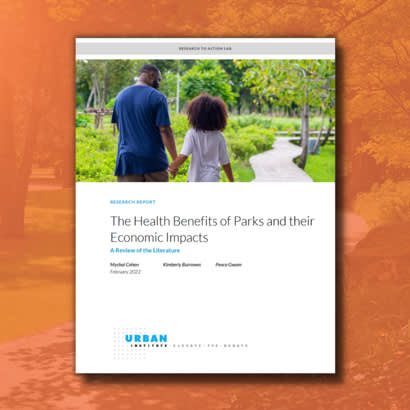
A Framework for Assessing Equitable Health Outcomes of Parks equips park and recreation agencies with tools and methods to simultaneously answer two important questions: 1. How equitable is our park system? And 2. What is the economic value of the health benefits our parks provide? The results equip agencies with data to demonstrate the economic value of equitable park systems and advocate for increased support from local decision-makers and elected officials.
The Framework walks park practitioners through five steps to arrive at an appraisal of their park system’s equitability and economic value. It also provides tips to translate those findings into action. Here’s an overview of the five steps.
Step 1. Identify Park Characteristics
Each park and park system is a unique blend of geography, infrastructure and programming. The particular characteristics of a park influence the types and degrees of benefits it delivers to users. The Framework guides park practitioners through analyzing two main categories of park characteristics: accessibility and size and amenities.
Accessibility examines how people get to a park and the barriers they face in getting there. It also considers barriers users face in accessing the amenities and programming within a park. GIS resources provide basic map data which agencies can supplement with more detailed information as needed to create a clear picture of how users are (or are not) accessing parks.
Size and amenities are joint elements that influence a park’s reach and diversity of use within a community. Park size and amenities (including programming) are not correlated – a large nature preserve may have relatively few amenities while a pocket park may have daily programming – but both factors influence how and why a community uses a park. With an assessment of park accessibility and an inventory of park sizes, amenities and programming in hand, it’s time to move on to step 2.
Step 2. Examine Who Has Access
This step builds on the work of the previous step to examine who is accessing a park system and for how long and why. Evidence shows park access varies widely among population groups – particularly along the characteristics of race and ethnicity, age and household income. These are not the only characteristics that matter when in measuring access and equitability, but they are a good place to start.
The Framework prompts park practitioners to examine these characteristics through the lens of proximity and use. By combining demographics with spatial data and usage patterns, agencies can develop an accurate picture of how equitable their parks are and begin to identify ways to make their parks more equitable.
Step 3. Select and Measure Health Outcomes
After collecting data in steps 1 and 2, park practitioners are ready to identify the health benefits of their parks and examine who has access to those benefits. The Framework considers health in four dimensions – physical, mental, social and environmental (watch for a future post that explores each dimension in more detail) and on three levels – individual, community and population. The Framework not only provides a suite of publicly available sources of health data, but also guides park practitioners through strategies to generate new locally specific health data as needed.
Agencies can use the methods in the Framework to investigate a range of health outcomes for their community including:
- How does proximity to a park affect the incidence of chronic medical conditions?
- To what degree does exposure to nature and green space reduce mental health service utilization?
- What is the relationship between spending time in a park and the sense of connectedness within a community?
- How much do parks contribute to improving air quality and reducing heat island effects in a community?
Step 4. Estimating Economic Benefits
The second-to-last step in the Framework gives agencies methods to estimate the economic value for the health benefits selected in step 3. Most often, the economic value is calculated as cost savings or cost avoidance for their community. In other words, parks save communities a lot of money by making people and the environment healthier. These health benefits reduce the need for expensive medical and mental health services, create safer communities and lessen the economic impact of climate change.
The results of this step enable park practitioners to quantify the health and economic value of parks in their community.
Step 5. Action Steps to Drive Equity
The final step provides actions agencies can take to apply the findings in steps 1-4 to build a more equitable park system. Actions include identifying disparities within the park system, creating data-sharing relationships with local healthcare organizations, partnering with local hospitals to assess community health needs and setting up systems for ongoing monitoring of health equity data.
Watch for a tool launching in 2023 that will help park practitioners work through the five steps described here. A Framework for Assessing Equitable Health Outcomes of Parks was produced by Urban Institute in partnership with NRPA and made possible by generous funding from The JPB Foundation.
Kevin Roth, Ph.D. (he/him) is Vice President of Research, Evaluation and Technology at NRPA.
Kelby Rose, Ph.D. (he/him) is a Technical Writer at NRPA.

